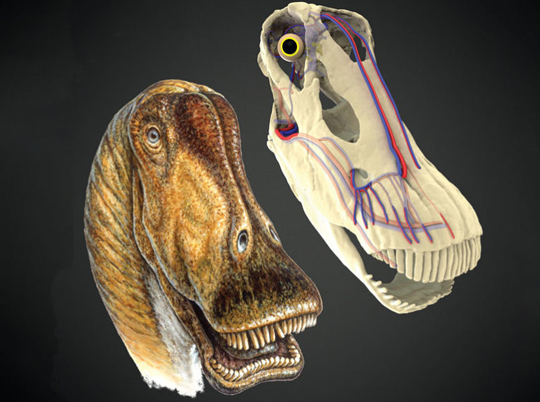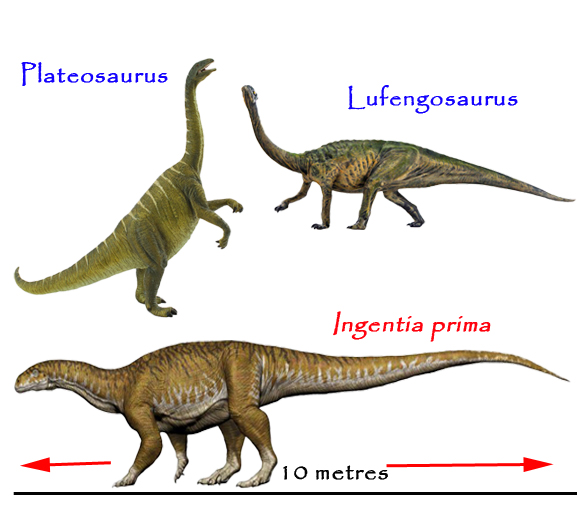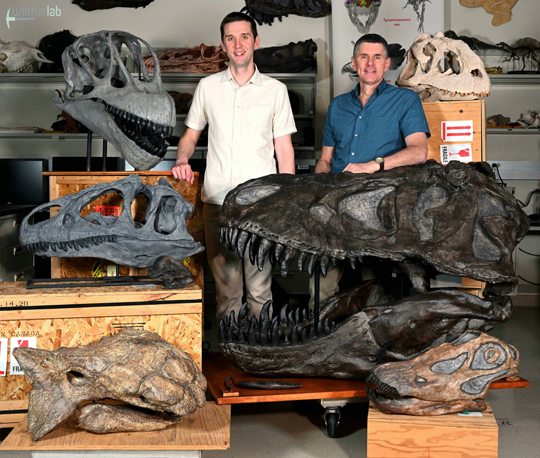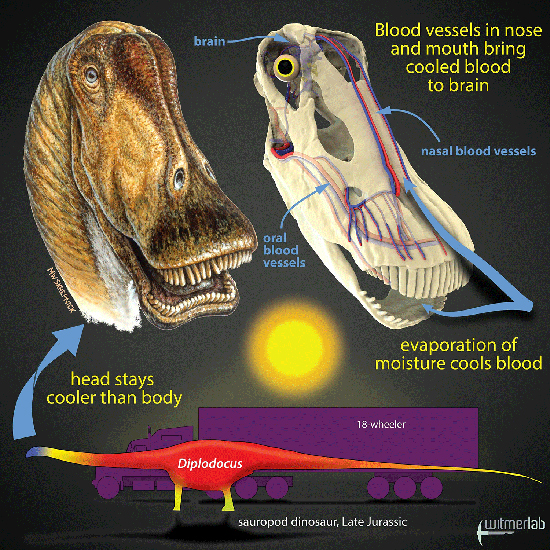How Did Big Dinosaurs Keep Cool?
Different Types of Dinosaurs Evolved Different Cooling Systems
Giant dinosaurs, be they bird-hipped leviathans such as Ankylosaurus, huge meat-eating theropods such as Tyrannosaurus rex and Carnotaurus, or the biggest terrestrial animals known to science, sauropods such as Diplodocus, Camarasaurus and Brachiosaurus all faced the same problem when it came to keeping cool. New research from the Heritage College of Osteopathic Medicine (part of Ohio University), suggests that different types of giant dinosaur solved the overheating problem in different ways. In essence, in order to prevent the brains of these large-bodied tetrapods from overheating, they developed different cooling systems in different parts of their heads.
Thermoregulatory Function in the Skulls of Diplodocids

Picture credit: Michael Skrepnick and Witmerlab (Ohio University)
How Big Dinosaurs Avoid Overheating their Heads
Researchers writing in the journal “The Anatomical Record”, the publication of the American Association for Anatomy, studied the skulls of a variety of large dinosaurs and compared them to living reptiles and archosaurs – crocodiles and birds and they concluded that different genera of giant dinosaurs solved the problem of overheating in different ways, essentially evolving different cooling systems in different parts of the skull.
Lead author of the study, Ruger Porter (Assistant Professor of Anatomical Instruction, Ohio University) explained:
“The brain and sense organs like the eye are very sensitive to temperature. Animals today often have elaborate thermoregulatory strategies to protect these tissues by shuttling hot and cool blood around various networks of blood vessels. We wanted to see if dinosaurs were doing the same things.”
Dinosaurs evolved from much smaller ancestors and as these animals grew bigger, so their surface area to volume ratios changed. Large bodies retain heat more effectively than small bodies, keeping warm may not have been too much of a problem for a thirty tonne sauropod, but losing heat, being able to keep cool, that would have been quite a challenge for such animals.
Big Dinosaurs Not Able to Seek Shade
Co-author of the study, Professor Lawrence Witmer (Department of Biomedical Sciences, Ohio University) commented:
“Small dinosaurs could have just run into the shade to cool off, but for those giant dinosaurs, the potential for overheating was literally inescapable. They must have had special mechanisms to control brain temperature, but what were they?”
As Dinosaurs Got Bigger so Thermoregulation Issues Got Bigger Too

Picture credit: Everything Dinosaur
An Explanation Based on Physics – Dinosaurs Kept Cool Using Evaporation
The researchers obtained carcases of birds and reptiles that had died from natural causes from various zoos and wildlife centres. They then plotted the location of blood vessels using CT scans in those part of the animal’s body that were associated with evaporative cooling. Areas such as the nostrils, the mouth and the eyes, areas where moisture is present would facilitate evaporative cooling of any blood that followed through these areas. The scientists accurately measured bony canals and grooves that conveyed the blood vessels within a series of dinosaur skulls.
Porter added:
“The handy thing about blood vessels is that they basically write their presence into the bones. The bony canals and grooves that we see in modern-day birds and reptiles are our link to the dinosaur fossils. We can use this bony evidence to restore the patterns of blood flow in extinct dinosaurs and hopefully get a glimpse into their thermal physiology and how they dealt with heat.”
Ruger Porter and Lawrence Witmer with Various Casts of Dinosaur Skulls

Picture Credit: Witmer Lab (University of Ohio)
Sharon Swartz, a programme director at the National Science Foundation, which funded the research stated:
“The discovery that different dinosaurs cooled their brains in a variety of ways not only provides a window into the everyday life of dinosaurs, it also serves as an exemplar of how the physical constraints imposed by specific environmental conditions have shaped the evolution of this diverse and unique group. Using a combination of technological innovation and biological expertise, these researchers were able to take a direct reading from the fossil record that provides new clues about how dinosaur skeletal form and function evolved.”
One Size Does Not Fit All
Expanding upon previous research, this new paper identifies that dinosaurs evolved subtly different solutions to the problem of heat stroke.
A key factor turned out to be body size. Small dinosaurs such as pachycephalosaurs had a very balanced pattern of blood vessels with no single cooling region being dominant. Such dinosaurs, most of which were around 2-3 metres in length could seek out shade to keep cool and therefore probably had fewer problems when it came to thermoregulation. Huge dinosaurs such as the sauropods and the ankylosaurs increased blood flow to particular cooling regions of the head, they had an overabundance of blood vessels in parts of their skull that would have contributed to cooling. This unbalanced vascular pattern allowed the thermal strategies of large dinosaurs to be more focused, emphasising one or more cooling regions.
Evaporation Helped to Keep Dinosaurs Cool
Picture credit: Witmer Lab (University of Ohio) with life reconstruction by Michael Skrepnick
Different Cooling Regions
Although sauropods and ankylosaurs (Euoplocephalus), all had unbalanced vascular patterns highlighting centres of cooling, they still differed. Sauropods, for example, had greater emphasis on the nasal cavity and the mouth as cooling regions, whereas it was the complicated sinuses of ankylosaurs that helped them to lose heat.
Porter commented:
“It’s possible that sauropods were so large, often weighing dozens of tons, that they needed to recruit the mouth as a cooling region in times of heat stress. Panting sauropods may have been a common sight!”
One interesting anomaly highlighted by this research is that many of the theropod dinosaurs such as Carnotaurus and Tyrannosaurus rex may have possessed balanced vascular patterns, similar to those identified in much smaller dinosaurs.
How Theropod Dinosaurs Kept Cool
Professor Witmer outlined how theropods might have kept cool:
“This finding had us scratching our heads until we noticed the obvious difference—theropods like Majungasaurus and T. rex had a huge air sinus in their snouts.”
Earlier studies had shown that large theropods had an antorbital air sinus that was supplied with many blood vessels. Air circulated through the antorbital air sinus like a bellows pump every time these animals breathed. Such an actively ventilated, vascular sinus would provide a potential cooling region for these huge bipeds.
The scientists hope to continue this area of study including other ornithischian dinosaur such as ceratopsids and hadrosaurs to see if these types of dinosaurs evolved different thermoregulatory strategies.
To read a related article on how armoured dinosaurs kept themselves cool: Convoluted Nasal Passages Helped Armoured Dinosaurs Cool their Brains.
Everything Dinosaur acknowledges the assistance of a press release from Ohio University in the compilation of this article.
The Everything Dinosaur website: Everything Dinosaur.


